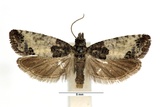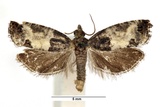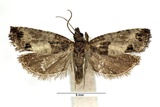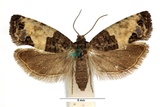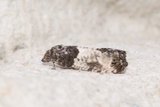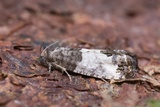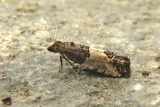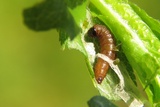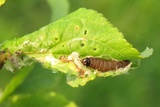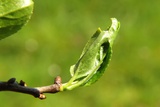Spilonota ocellana (Denis & Schiffermüller, 1775) Species
Last modified: Dec. 4, 2024, 2:07 p.m.
A common species throughout Belgium.
Details
- Classification
- Family: Tortricidae > Subfamily: Olethreutinae > Tribus: Eucosmini > Genus: Spilonota > Species: Spilonota ocellana
- Vernacular names
- Rode knopbladroller (NL), Bud Moth (EN), Roter Knospenwickler (DE)
- Synonyms
- Spilonota luscana (Fabricius, 1775)
- First mention in Belgium
- De Sélys-Longchamps E. 1844. Énumération des insectes Lépidoptères de la Belgique. — Mémoires de la Société royale des Sciences de Liége 2: 1–35. On page 21.
- Status
-
Native
Distribution
Imago
Wingspan 12–17 mm. Can be very similar to Spilonota laricana. Specimens with an ochreous tinge to the ground colour should be S.ocellana.
A quite variable species in density and colour of the markings, this moth can usually be identified by the well-defined darker basal patch and the small blackish triangular blotch on each forewing, forming a diamond shape when at rest.
Egg
Eggs laid one by one or in groups of 3-5, they are oval, flattened, transparent and shiny. They develop within 8 to 12 days.
Cocoon/pupa
Lenght 7–10 mm, light brown with blunt rounded apex and eight thin hooked apical setae. The pupal stage lasts 9-15 days.
Bionomics
The larva feeds at first on the underside of a leaf, living in an open-ended silken tube. Overwinters as an early instar in a silken hibernaculum on a twig, branch or bud. In spring the larva eats into leaf and flower buds causing them to wither, later feeds in an untidy spinning of several leaves.
The adults come to light.
Flight periods
The adults have been seen from mid-May towards late October. Most observations during July.
Observed on
- Substrates:
- Polyphagous
The ployphagous larva lives on different species of deciduous trees and shrubs like Malus, Sorbus, Prunus, Pyrus, Cydonia, Crataegus, Pyracantha, Chaenomeles speciosa, Rubus, Betula, Carpinus, Alnus, Salix, Myrica gale, Hippophae rhamnoides, Quercus, Acer, Juglans, Rhus, Berberis vulgaris, Erica tetralix, Vaccinium myrtillus, Vaccinium uliginosum, Vaccinium vitis-idaea and Kalmia.
This is a polyphagous pest of rosaceous fruit trees and forest species.
Habitat
It inhabits open woodland, hedgerows, orchards, parks, gardens and larch plantations.
